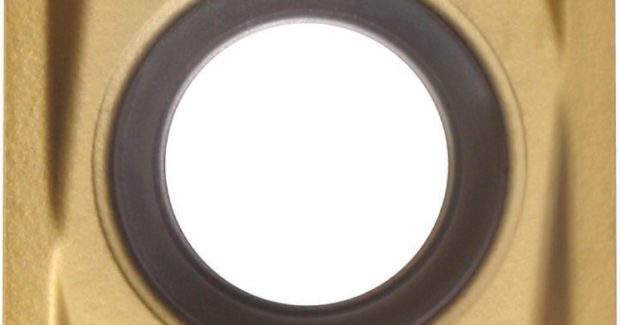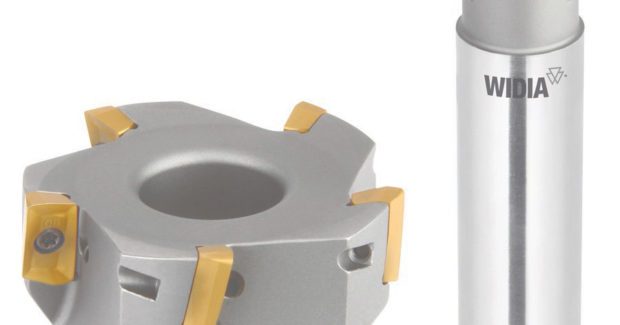Advanced Milling Grade for High Temp Tough Superalloys
The cobalt-rich substrate in the new WS40PM indexable milling grade from WIDIA makes it a first choice for machining titanium and other superalloys.
Posted: December 10, 2018
The new WS40PM indexable milling grade from WIDIA Products Group (Latrobe, PA) provides robust fatigue resistance and edge integrity, while the multiphase AlTiN-TiN PVD coating reduces tool wear, making it a first choice for a wide range of high-temp steel alloys, austenitic and PH stainless steels, and nickel-based super alloys, such as Hastelloy and Nitronic, and titanium. Josef Fellner, the manager of the turning and indexable milling portfolio at WIDIA, noted how the company recently took this new advanced milling grade on a world-wide testing tour, with results that were quite impressive:
- An aircraft manufacturer enjoyed a 90 percent reduction in machining time per piece and increased tool life by 50 percent during Ti-6Al-4V face milling operations.
- Insert flank wear decreased by more than 90 percent at a UK shop cutting Inconel 625, resulting in a 70 percent reduction in tooling costs.
- At a turbocharger producer in China, tool life increased 80 percent while machining an austenitic stainless steel component using WS40PM, with improved part surface quality, reduced cutting forces and better chip flow.
- In another titanium component, the WS40PM/VSM490-15 platform doubled metal removal rates and delivered 80 percent longer tool life through increased depth of cut and feed per tooth in face and shoulder milling operations.
- The testing laboratory for a well-known brand of machine tools reports metal removal rates 49 percent greater when shoulder milling Ti-6Al-4V.
In each instance, WS40PM competed with the test subject´s legacy carbide grade. Speeds and feeds were kept the same or in some cases increased to take advantage of the exceptional toughness, wear-resistance and ability to resist thermal cracking in this advanced milling grade, which is designed to meet the needs of the aerospace, defense, and medical industries where titanium is used for everything from landing gear and seat tracks to lifesaving implants and surgical instruments. As the testing results show, however, WS40PM is suitable for far more than titanium: high-temp steel alloys, austenitic and PH stainless steels, nickel-based super alloys such as Hastelloy and Nitronic – these materials cause tool failure due to built-up edge (BUE), notching at the depth of cut line, cratering, chipping, and extreme heat generation, which in the case of wet-cutting operations leads to cracking.
“WS40PM´s advanced cobalt-rich substrate provides robust fatigue resistance and edge integrity, while the multiphase AlTiN-TiN PVD coating reduces wear,” says Mike Sperhake, EMEA-region product specialist for WIDIA. “Using an initial cutting speed of 175 fpm (53 m/min) we´re seeing 25 percent to 35 percent productivity gains and consistent improvement in tool life, even when milling very tough materials like Ti-5553 and Super Duplex steels.” He recommends a balanced approach to cutting parameter selection: “As radial engagement increases, cutting speeds should be reduced proportionately,because the amount of heat entering the insert goes up substantially on heavy cuts. At around 90 percent engagement, for instance, you´ll probably want to reduce the rpm by 25 percent or so, depending on the material. Feedrates may also have to be lessened somewhat, depending on setup and machine rigidity. And smaller cut widths, spindle speed and feedrates should be kicked up substantially.”
“Going too easy is a common mistake when machining titanium and other difficult materials,” adds Sperhake, “leading to poor productivity levels and shortened tool life. For example, problems such as BUE and edge wear can often be eliminated by pushing the tool harder. Tool life, especially in superalloys, is a three-legged stool of feed, speed, and cutter engagement. Each has a direct impact on the others.” Success with superalloys takes more than a good carbide grade, however. Sperhake also recommends increasing the cutting fluid concentration, and using a high-pressure coolant pump wherever possible. Selecting the right cutter body for the application is likewise important. The VSM490 shoulder mill offers a state of the art insert and cutter design, one that supports WS40PM and other high-performance grades.
Finally, consider the machine tool, toolholder, and spindle interface. Rigidity across the board is needed for productive titanium machining. The KM4X platform is “the strongest connection available, period,” states global product manager Bill Redman. It is available on a wide variety of toolholders and machine tools alike. “From Tier 1 aerospace suppliers to the job shop on the corner, everyone wants the same things from a tooling solution: higher accuracy, better surface finish, reliability and productivity,” adds Sperhake. “All are critical factors to their success, and that´s what we intend to deliver. WS40PM is a big part of that.”
WIDIA has also created an app to quickly access machining speeds and feeds for their tooling without interrupting production. The newly released Machining Central app scans the WIDIA product barcode or searches the tool’s corresponding order number or an ANSI or ISO catalog number to automatically generate product information and availability along with feeds and speeds in seconds. Designed for machinists and engineers alike, the Machining Central app also addresses specific machining needs that our recommended speeds and feeds may not quite address. The app features three NOVO (a WIDIA-developed programming software) based calculators, including end milling and face milling calculators.
“We strive to provide resources to increase productivity for our valued customers – Machining Central is just another way we’re doing that. The app provides scan, search and calculate functions, all in the palm of the user’s hand – simple and quick, without interrupting productivity. We loves getting app user’s feedback, as it’s essential to development and improving the user’s experience,” said Tarah Mendez, the digital marketing program manager with WIDIA. Machining Central can be downloaded from the App Store or Google Play. After downloading the app, click here and provide your feedback to receive a complimentary WIDIA-GTD bottle opener.
WIDIA Products Group, 1600 Technology Way, Latrobe, PA 15650, 724-539-5000, www.widia.com.












